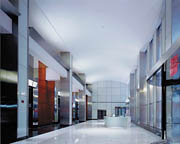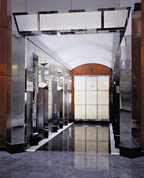

"It's quite interesting," said Mihai Marcu, AIA, president and chief executive officer of the Pittsburgh-based architectural firm. "The building itself was quite old, but designed rather well a long time ago. It's a handsome building, without a great deal of character."
The architect explained that Mellon Bank intended to vacate a substantial portion of the building to open it up to potential tenants. "The problem was that it was not inviting at all," said Marcu. "They spent a substantial amount to do an exciting lobby and front." The logic being that an attractive lobby would lure in new tenants.
Originally, the 40-story structure was created as the corporate headquarters for U.S. Steel. The building exterior was designed with tightly closed vertical piers that resulted in small window openings and permitted no visible recognition of the lobby to the passer-by, according to IKM. Before the renovation, the existing interior design consisted of dark surfaces with stainless steel accents. The overall space lacked natural light because of its east-facing direction. Also, it was shadowed by the neighboring Two Mellon/Union Trust building.
According to the firm, the design approach was to infuse the space with natural light and augment it with artificial lighting to play on a theme of light and brightness. "We opened a lot of the area up," said Marcu. "There's a lot more glass than before. You can see all the way in. It's much more inviting and effective."

Opening up the space
It was decided that white marble would be a favorable choice for the floor. "We took up a dark color paver, which had been in the space previously," said Project Manager Joe Beerens, AIA, also of IKM. The firm's design team also included Vice President and Principal Designer Bob Moro, AIA, and Bill Thomas, who served as design consultant."We used a combination of Carrara White slab in a 24- x 48-inch running pattern," said Beerens. "It was a minimalist statement using materials that were timeless and light. We were asked to remove the dreariness and darkness. We did have a couple of choices that were offered. We used the white marble for reflecting and because it's Class A - the hardest marble, which can stand up in high-traffic areas."
White Portland cement and sand were used as the setting bed for the Carrara marble. These materials were used to prevent staining of the white marble, according to Mick Nardozzi of Cost Company in Pittsburgh, the installer for the project. "Protecting the newly installed marble flooring from the building tenants was one of the largest challenges that we encountered," he said. "The stone was installed at night. Each morning, we had to protect the stone flooring that was just installed and make sure that nobody stepped on it the next day."
Complementing the white marble on the floor is Boreal Green granite from Canada. The material was used in the elevator lobbies. On the back wall of these spaces, 3¿inch-thick white onyx panels were employed. "They're all book-matched, and a light box was placed behind them so that they were actually illuminated," said Beerens. "[At first], we weren't sure how to make it work." The architect explained that the walls are 7 x 11 feet. Each large stone was subdivided into nine panels and set into a polished stainless frame.
Additionally, the 18 elevator cabs were redone. "We used back-illuminated glass panels with a white inner layer," said Beerens. "A green granite base was used in the cabs to introduce stone up through the building."
To open up the interior to the street, a series of non-structural columns were taken out. "We took up columns that were very closely centered," said the architect. "We discovered that every two of them out of four were false. We were able to remove those." A new structural glass window wall to the street was then created in that space.
Further adding to the ambiance of the room is a reception desk designed as a tapered glass oval with Carrara White marble. According to Beerens, the marble top is 1 1¿inches thick, and there are 2-inch-thick marble end panels to add substance. Glass was bent to form the body of the desk, which was also backlit. "That was a real challenge to build," said the architect.
In total, installation of the stonework took about six weeks to complete with a crew of four stonemasons, according to Nardozzi. Another challenging aspect for the installers was trying to keep the elevators and lobby open while doing the work. "The building was fully occupied, and the lobby was operational during the entire construction period," said Nardozzi. "Coordination was a major issue."
For the exterior, the stone paving from the lobby was taken into the street. A new revolving door was also installed. According to Beerens, there were low stone planters on the exterior. "We chose to bring them up slightly higher and put 3-inch granite caps on them. Additionally, there is a low bench outside, which runs the full length of the lobby. "Stone was a nice touch," said the architect.
